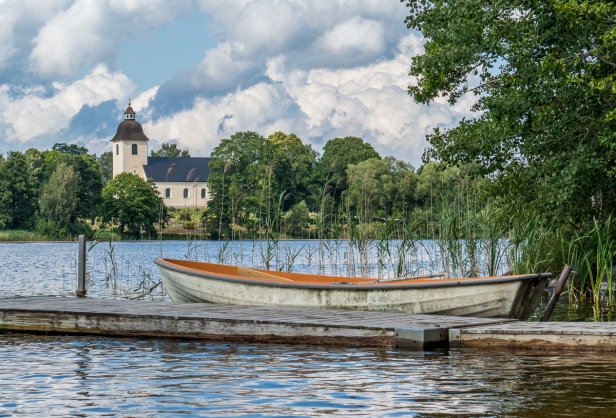
7-22 July 2015. We returned to Vancouver May 7th after five months in Australia, New Zealand, and the South Pacific. During two months in Vancouver we housesat for three different families, and visited friends, family, doctors, dentists, our financial planner, our accountant, some government offices, and a sick cat at the vet’s. We rented a car, went shopping, helped a friend move, and went to a gathering of friends down in Washington for four days. It seems that every time we land in Vancouver our time is sucked up into a whirling vacuum of busyness, good busyness, taking care of business and catching up with friends and family. There were many people we wanted to see, but we simply ran out of time.
On July 7th we scooped up our gorgeous fifteen-year-old granddaughter, Amanda, who lives with her mom near Vancouver, and took her to Sweden to visit her dad, Jason, her step-mom Rebecca, and her four (and almost five) Swedish siblings. It was her fourth, and our sixth, visit to Sweden.
The family home is in a tiny village near the town of Åtvidaberg, near the city of Linköping. About an hour’s drive from there, and about a half hour from the east-coast summer-holiday town of Västervik, way out in farming country is a village that is not even a village, not even a hamlet, called Getterum. In Getterum is a place that the family sardonically calls Southfork. Yes, like Southfork of Dallas fame. It is their summer home. Unlike the magnificent mansion and estate seen in Dallas, this Southfork is an old, charming, rustic, somewhat dilapidated ex-farmhouse and outbuildings on about a half-acre of land, surrounded by farmland and forests and endless fields of green: a place to relax, a place to play, a place where the kids can run loose and nobody has any deadlines.
Getterum is pronounced yettarom, sort of. We never could wrap our non-Swedish tongues around it, but of course our running joke is we know we’ve arrived when we get to ‘get a room’. Speaking of rooms, Southfork is far too small for four adults, one almost-adult, and four rambunctious children, so Don’s son arranged for us to stay in the two-room guest cabin at the back of the house across the road.
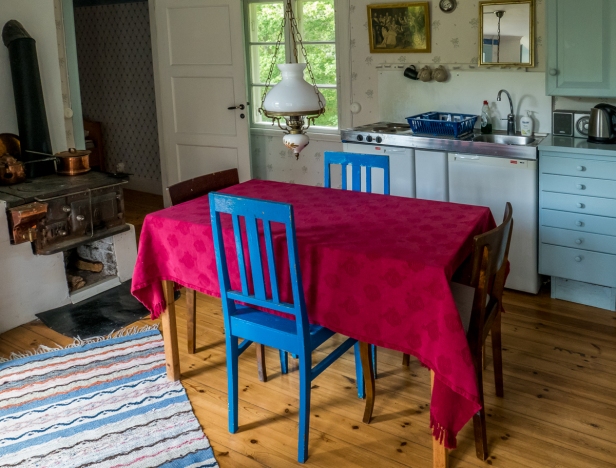
The house across the road is the family home of a colleague of Jason’s and is typical of Swedish rural homes.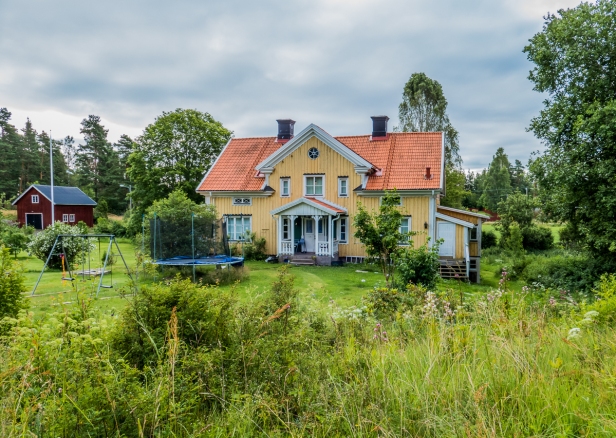
Swedish country homes are painted either yellow or dark red. Southfork is yellow, but many of the homes are dark red like the guest cabin. Known as Falu Red, it originated from the tailings of the hellish Falun copper mine, which dates back to 850AD. The tailings were hematite, and several hundred years ago it was discovered that hematite helps preserve wood. The hematite tailings of Falun were a reddish brown colour and paint was made by mixing it with linseed oil and other ingredients. The King gave small cottages to the soldiers on the proviso that they were well cared for. In 1684 it was declared that all officers’ houses must be painted red, both to mark it as a gentleman’s house and because it protected the building. The red also imitated the red brick of the wealthy. By the end of the eighteenth century the more successful farmers began painting their cottages red and thus were considered to be “getting above their station”. Eventually the wealthy wanted nothing to do with the red houses of the uppity farmers so they turned to white, and more commonly, yellow. I don’t think it has anything to do with wealth these days, so much as tradition. About ninety percent of rural houses are either red or yellow. The other ten percent are white, and I did see a rather radical pale green one. The Swedes are a conservative lot. Recently an artist painted his house in gradations of orange through yellow from the roof down, and a local councilor complained that it was un-Swedish. Plain yellow, or plain red please.
The owner of the very smart yellow house with the red guest cabin is a teacher. Imagine my surprise when I’m out exploring the land one day, following country trails, and I come across this:


A tidy flock of sheep on the land of a schoolteacher, apparently cared for by a local farmer.
It is permissible in Sweden to walk anywhere in the country. There’s no such thing as “no trespassing”. So we walk all over.

Except we don’t walk into the field where a very large bull takes far too much interest in us. It doesn’t matter that there is an electric fence between us and the bull, Don and I, nine-year-old Markus, and seven-year-old Elisabeth decide we should move along as quickly as we can. On the other side of the road. And no running. Then we come to a laden cherry tree at the side of the road and forget all about the bull. Reaching as high up the tree as we can, we stuff our faces with the sweet fruit, and collect some in our pockets to take home. There are still plenty left when we leave: the ones that are too high to reach.
As we walk I ask the kids how to pronounce the road signs we see. There is a small one I’ve been curious about so I ask for a translation. I’m told that it is advertising a small place close by selling antiques and second-hand goods. All the children are completely bi-lingual, and tease their father about his Canadian Swedish accent.
In the forest there is an abundance of wild raspberries, and we frequently see tiny sweet wild strawberries. Picking wild raspberries in a light rain, the ground is covered in tall grasses, shrubs, baby oak trees, and mixed in amongst it all, raspberry bushes. I clasp a jar firmly between my legs and pick the reddest ones, two or three or four at a time, and drop them into the jar. Everywhere I look I see more and more of them, in all directions. The ground is very uneven, and because of the grasses and shrubs it is impossible to see the surface. Suddenly, as I move, my foot goes down two feet lower. I’m part way down in an unexpected trench. I call it the Mariana Trench because we’ve been talking about that at dinner the night before.
And the blueberries! To say there’s an abundance of them doesn’t even come close. This forest is carpeted in small shrubs: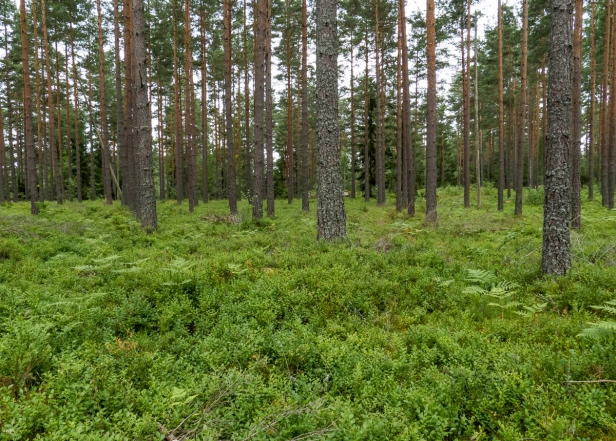
Look closer. They are blueberry bushes, as far as the eye can see.
Just about every day any ragged collection of the household – me and Don or either one of us, and any number of the kids go berry picking. And eating. The tiny strawberries, the size of my smallest fingernail, are the best find because they are the most rare. I am reminded of picking wild strawberries when I lived in the far northwest of Canada. They taste like nothing else on earth: tart and sweet and heavenly. The raspberries are quite plentiful, and the best I’ve ever tasted. The blueberries are so plentiful that we’re all completely blasé about them.
I am not blasé about the beauty of the butterflies
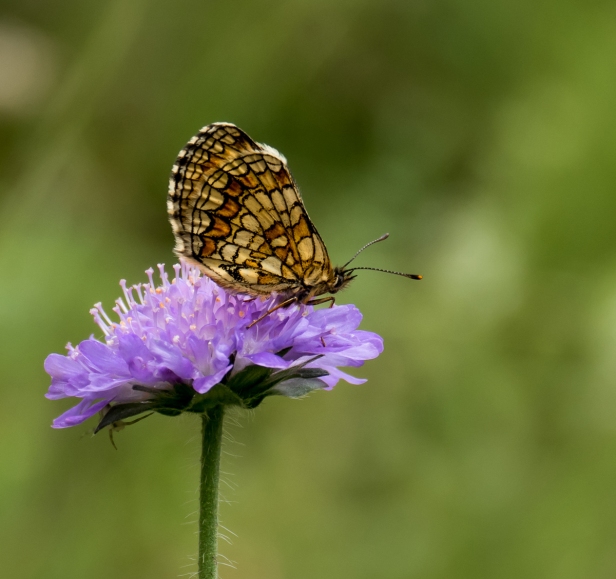
and the flowers.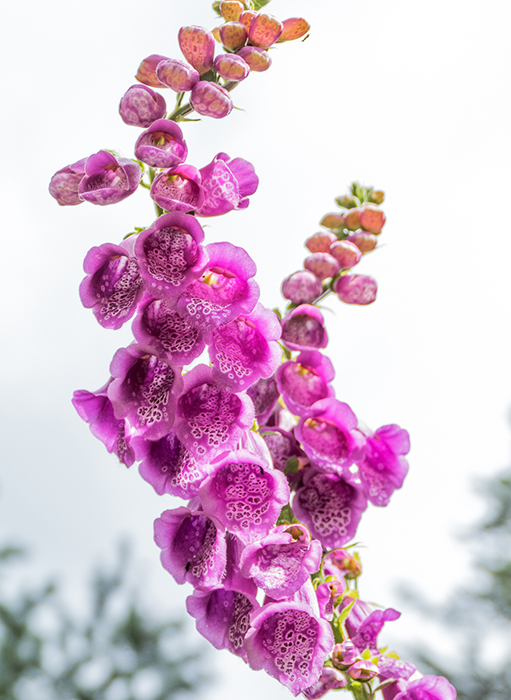

Our days are filled with family fun. We play Trivial Pursuit. We cook hot dogs and marshmallows around the campfire. We go go-karting. Jason wins. Eleven-year-old Mattias is second. I come last; even Elisabeth beat me! We cook and eat many meals together. Don plays badminton with Elisabeth, Mattias and Markus. Elisabeth puts all she can into it.
I (briefly) ride a bike for the first time in years,

and Don and Jason and the kids get in a little target practice.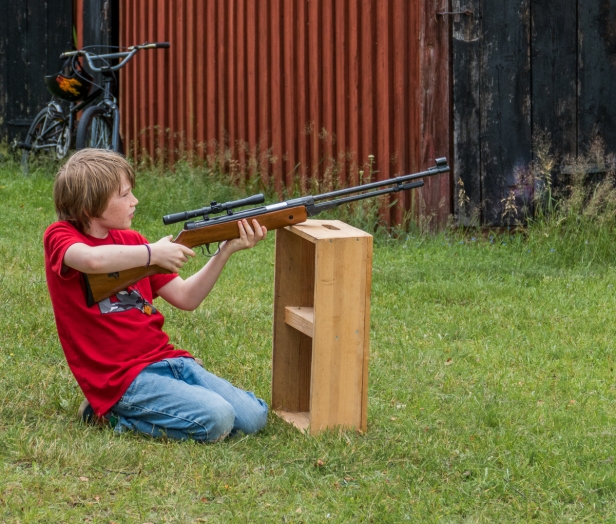

More than once, well more than twice, well probably several times actually, we go to the nearby lake where everyone except Rebecca, Don and me plays in the water until they turn blue. Even little Katie, the youngest, gets into it, despite the cool weather and freezing water.
The opening photo above, of the tranquil scene at the lake looking towards the church at Hjorted, the nearest village, belies the tornado of activity in the water.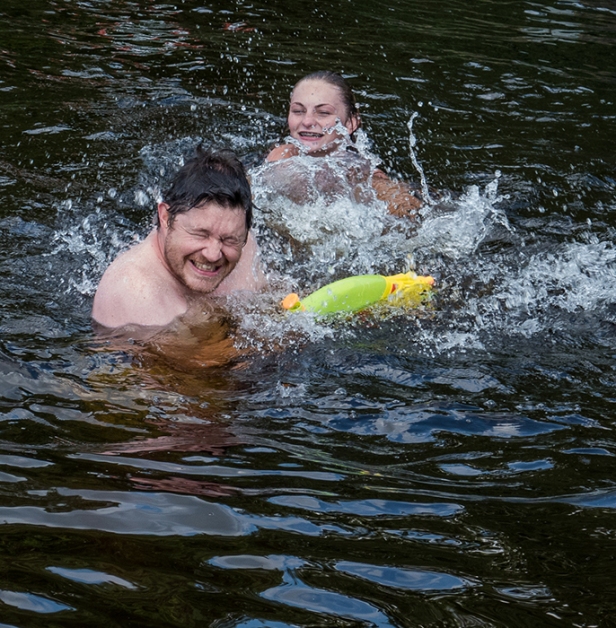



I don’t care how cold I am, I’m not getting out of the water.
We go to Stockholm for a day: Don and Jason and Amanda and me. We leave very early and drive north for about three hours to the edge of the city then take the subway into the centre.
Stockholm, the capital of Sweden, is built on fourteen of the 30,000 islands of the Stockholm Archipelago in the Baltic Sea. The city has more than fifty bridges. Ferries and sightseeing boats also connect the islands. Not surprisingly it is known as the Venice of the North.
About a thousand years ago marauding gangs frequently attacked the capital Sigtuna. Legend has it that the burgers of Sigtuna hollowed out a log, filled it with gold and set it adrift. After several days it came ashore on an island. They named the island Stockholm, meaning log island, and decided it would be the place for the new capital. It was easier to defend since it was an island, and it is situated at the inlet to Lake Mälaren, which was important for Baltic trade. The island, now called Stadsholmen, is also known as Gamla Stan, meaning old town, and dates back to the thirteenth century.
From Gamla Stan, the medieval centre of the city,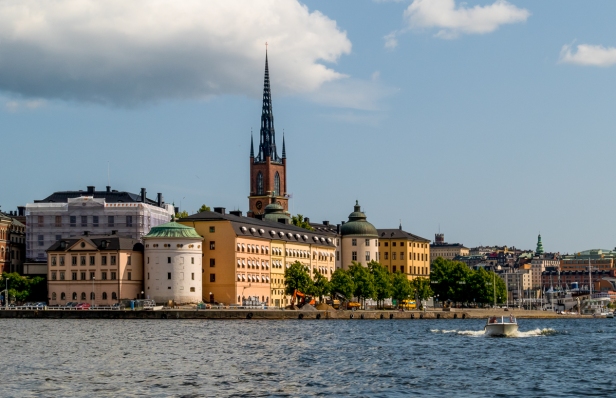


we take a boat tour around the islands of Kungsholmen, Långholmen and Reimersholme. We travel through narrow canals and past leafy shores, discovering a more urban area. An ever-changing view of Stockholm summer-time daily life is revealed as we cruise by.
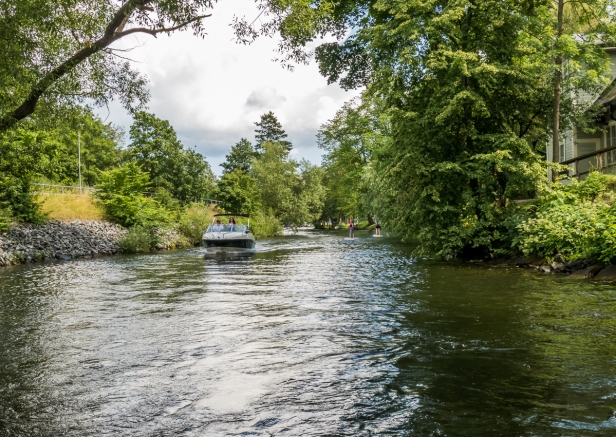


Arriving back in Gamla Stan we explore the enchanting old town with its narrow cobblestone streets and alleyways, and archaic architecture of ochre and rust coloured buildings. Once away from the main square it is as if we have gone back in time,
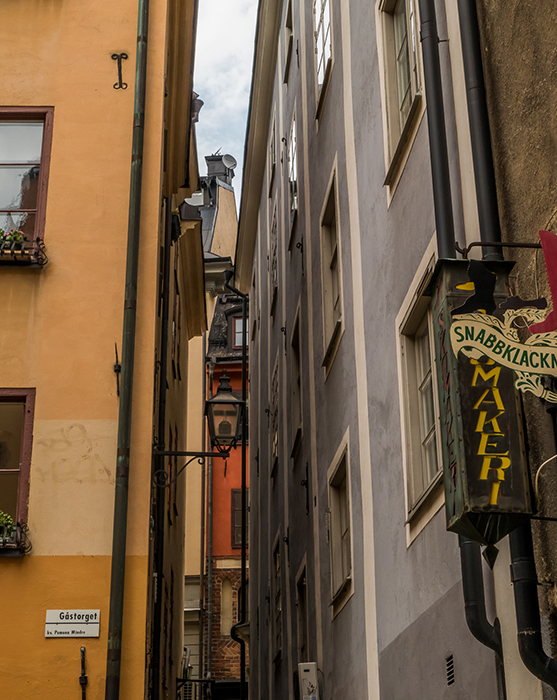

until we come across this
and think we’ve teleported to another planet.
Finally we collapse at one of the many cafes because by now we are exhausted, but as usual food and coffee help.
At last it is time to head back to Southfork. Getterum to Stockholm, Stockholm exploration, and back to Getterum, is a lot in one day we discover.
One place we didn’t visit on this trip, and that I highly recommend, is the Vasa Museum. Don and I went there on an earlier visit to Stockholm. We read about it and thought, Oh yeah, some old boat. Maybe we’ll spend half an hour there. We were there for three hours! It’s an original authentic three-hundred-year-old warship that had sat at the bottom of Stockholm harbour after sinking within minutes of being launched. That’s a whole story in itself, but it boils down to royal hubris. The story of the raising, preservation, and housing of the ship in a specially built museum is fascinating. There are life-sized replicas of the sailors’ cabins, ramps all around the boat so you can see it at all levels, and a video about the story of a warship that sank to the bottom of the harbour on its maiden voyage. It is so much more than some old boat.
Back in Vancouver we resumed our hometown busyness while house sitting for friends. On August 23rd we flew to Istanbul.
Next few posts: travels in Turkey.
In the south the earth turns towards shorter days, in the north towards longer days. May you all have joyous and heart-filled celebrations at this time of the changing of the light. In sunshine or in snow may you be blessed with kindness and love.
Alison and Don
All words and images by Alison Louise Armstrong unless otherwise noted
© Alison Louise Armstrong and Adventures in Wonderland – a pilgrimage of the heart, 2010-2015.

LOVE! I’m embarrassed to admit that I’ve never thought twice about Sweden, but now I want to go! Your writing and images are stunning and capture so much beauty and your natural enthusiasm. Thank you, as always, for sharing your adventures. I’m inspired!
LikeLiked by 1 person
Thanks so much Jen, I glad you enjoyed it. We always love our time in Sweden with the family. I’m not so sure about going in the winter – brrrrrrr, but it’s lovely in the summer. And all those berries!
Alison
LikeLiked by 1 person
I’ve never made it to Sweden Alison even though my DNA suggests I was there in a past life. I know I would fall in love with the wilderness. I remember rambling through north country of Alaska gobbling down blueberries and other goodies (while keeping an eye out for grizzlies who also like berries and are a bit territorial about it). And that green motor bike… I am thinking it would be an ideal mode of transportation for the Green Hornet. Thanks as always for taking me along on your adventures. –Curt
LikeLiked by 1 person
Sweden is very beautiful. It doesn’t have the towering mountains of Alaska or Yukon, but certainly has it’s own understated beauty. I too ate a whole pile of berries while living in the north – saskatoons, blueberries and strawberries. I must say I love berry picking in Sweden for *not* having to be on the alert for foraging bears.
Isn’t that motor bike a hoot?! Quite the style!
Alison
LikeLike
Ah, but Alison, the bears add a certain sweetness to the berries.Peggy and I kayaked up in Prince Albert Park, and our van, Quivera, was made in Saskatoon. –Curt
LikeLiked by 1 person
Wonderful as always! I love Sweden in the summer and this post shows why! Happy Holidays Alison!
LikeLiked by 1 person
Thanks Cindy. Having lived in/near the Yukon for ten years I think if I was to go that far north again in the winter I’d probably choose Norway or Iceland – for something different. But Sweden in the summer, yes, it’s just lovely!
Happy Holidays to you too.
Alison
LikeLike
I visited Stockholm and the countryside in wintertime, so it was really great to see what it looks like in summer! Now I want to go back!
LikeLiked by 1 person
Yes, go back in the summer. It’s so green, and lovely, especially out in the country.
Alison
LikeLike
Beautiful writing and beautiful pictures…Thank you!
LikeLiked by 1 person
Thank you so much Dan, I’m glad you enjoyed it.
Alison
LikeLike
Never been there but once again your post makes me want to go. Sending a special end of year big hug to you two and wishes that 2016 brings days of laughter and peaceful nights. Love, Paulette
LikeLiked by 1 person
Sweden is beautiful, and definitely worth visiting. A special end of year big hug to you two too! May 2016 bring all you could possibly wish for. Love and hugs
Alison ❤
LikeLike
A wonderland. Can’t wait to hear what you thought of Turkey. Hope Santa treats you well, now and always.
LikeLiked by 1 person
Thanks Marsha, it is indeed a wonderland. Turkey was fabulous! Many posts to come. Hope Santa treats you well too.
Alison
LikeLiked by 1 person
Thank you, thank you, thank you for the visual tour and the non- visual of visiting family in such a beautiful place. Love and peace.
LikeLiked by 1 person
My pleasure Kate. And thank you! It is a beautiful place, and always so wonderful to be with the Swedish branch of the family.
Alison
LikeLike
thanks for the well documented
fun, friendly adventurous
holiday 🙂
LikeLiked by 1 person
You’re welcome
on our fun family
holiday in sweet green
Sweden.
Alison
LikeLike
Such great adventures. Thanks for sharing them. Your pictures are amazing. So crisp, clear and beautiful. Love the sheep and the butterflies and all the greenery!
Peace and Joy
Mary
LikeLiked by 1 person
Thank you so much Mary. Sweden really is very beautiful, especially out in the countryside. We always have a wonderful time there.
Alison
LikeLike
Your photos look like paintings! Beautiful.
LikeLiked by 1 person
Wow, thank you so much Angeline!
Alison
LikeLike
I cannot tell you how many times I’ve desired to buy a motorcycle, then for one reason or another never did. Today, now I want to buy THAT motorcycle, whatever it is. And for some reason, today I really like the photo of Gastorget street…the tightness of all the buildings is interesting. And I’ve just realized that I never quite got to Sweden either. My dentist is from Sweden, has a photo of their king (is it?) in his waiting room. And another of Stockholm, which always makes me want to go there. All just lovely photos again, of course. The one of Don is especially…what’s the word?…charming. If he’s wearing Merrells, I have those same boots.
LikeLiked by 1 person
Isn’t that motorcycle wicked! I loved photographing all the narrow old streets of Gamla Stan – I find the flow of it and the architecture has an organic truthful beauty that we rarely see today. Don is charming? Lol. He laughed too. Yes he’s wearing Merrells. He won’t wear anything else.
Alison
LikeLike
Yeah, I love architecture, old stuff, and those streets are full of it. Maybe past life stuff? Do IS charming! And Merrells rule, I wear nothing else. Is that photo HD in the camera, or post edit? It’s an interestinly well-done effect either way…someone mentioned it looked like a painting.
LikeLiked by 1 person
I can only think HD means High Definition, and I don’t even know if my camera does that. I should look into it! i.e. read the manual. What a concept. I did do some post on it – adjusting a whole bunch of stuff – exposure, highlights, shadows, contrast, clarity, etc.
I’m assuming you’re talking about the photo of Don with the pellet gun?
LikeLike
one other thing…what is the name of the ashram you visited in India…and wasn’t it in or near Trivandrum? I’m planning to visit one or two while I’m there
LikeLiked by 1 person
We were at Ramanashramam in Tiruvannamalai. It’s about a ten hour drive from Trivandrum, inTamil Nadu.
http://www.sriramanamaharshi.org
LikeLike
Oh yeah…I remember you telling me, but couldn’t remember the name. I guess I won’t be able to make it over there, only have nine days. But it’s not like there are no gurus and ashrams in Kerala!!
LikeLiked by 1 person
What a precious time with family. All the best to you and yours.
LikeLiked by 1 person
Thanks SGMT, and the best to you and yours too!
Alison ❤
LikeLike
Wow it’s just amazing😍😍😍
LikeLiked by 1 person
Isn’t is beautiful. We’ve been so many times I think we almost take it for granted, but every time I find more beauty.
Alison
LikeLiked by 1 person
It’s truly truly awesome. .😆
LikeLiked by 1 person
What a great country escape. There is nothing better than summer days off in a meadow, in a spartan little house, picking berries, playing games … ahhh! As much as I love roaming to exotic places, some downtime in a family spot like this is so rejuvenating. You both look so alive and relaxed; it’s fun to see your faces every once in a while (says the one who has only just come out of hiding!).
I was just thinking a few days ago that I was eager for your Turkey posts – glad to hear they are in production and on the way!
LikeLiked by 1 person
It was a wonderful time, always is. We’re way out in the country and can roam anywhere we like. We always have a lot of fun there. Turkey is not actually in production, but will be very soon 🙂
Alison
LikeLiked by 1 person
Loved reading the story behind the Swedish tradition of painting the country homes yellow or red and the name “Southfork” made me laugh! Sometimes when I’m reading your narrative and looking at your gorgeous pics I feel transported to the places you’re writing about and this post was one of those times. I enjoyed my virtual visit and the beautiful landscapes as well as meeting your Swedish family. And it looked much warmer than I imagined! Anita
LikeLiked by 1 person
Thank you so much Anita! I’m delighted you felt transported to Sweden. It’s a wonderful place. It can be quite warm there in the summer. This time it was coolish, but we’ve been there for 25-30 degree (centigrade) days too. We’ve always gotten a laugh out of Southfork – it couldn’t be more different but it is their summer home 🙂
Alison
LikeLike
I went to Sweden many years ago, when I was 15, on a student exchange. I still remember the Warship Vasa (amazing), and I keep in touch with my host family! I was there in February and have great memories of skating on the gorgeous frozen lakes and rivers. Your post comes at an interesting time as I’ve been thinking a lot about returning after all these years. Thanks for the wonderful read and happy holidays to you and your family.
LikeLiked by 1 person
February brrrrrrr. I imagine it’s much like most of Canada in February – frozen and covered with snow. Maybe you’ll head back in the summer – it’s so green and beautiful.
Happy holidays to you too.
Alison
LikeLike
Lovely!!!!
LikeLiked by 1 person
Thanks Nicole. Yes it is!
Alison
LikeLiked by 1 person
Oooh fresh strawberries, cherries, raspberries, blue berries …. I am officially jealous. I love picking and earing fruit right away – such a huge treat! Sounds like a very fun time.
LikeLiked by 1 person
It was a wonderful time. And yes, all the fresh wild fruit! Just fabulous. We always enjoy our time in Sweden.
Alison
LikeLike
I especially love the photo of the little kitchen with the little table.
Looks so welcoming, so comforting,
LikeLiked by 1 person
Thanks Mary. It was such a sweet little cabin, very comforting. And with so many of us it was good to be able to escape now and then 🙂
Sweden in the summer is just lovely.
Alison
LikeLike
Quite a contrast to your previous travels, Alison! I don’t fancy that cold water a bit but I’d love to visit Stockholm Looks like you were all having a great time together. Hope you’re having a happy festive season. Very best wishes for 2016 🙂
LikeLiked by 1 person
We had a wonderful time. You’re right, it is different from our other travels in that in Sweden it’s all about family. Stockholm is definitely worth a visit.
Merry merry changing of the light to you too.
Alison
LikeLiked by 1 person
What a wonderful post! Gorgeous pictures and love the history lesson 😉 I love Sweden, have been there four times myself and will probably visit more often, as two of my dear friends live there. Happy onward travels!
LikeLiked by 1 person
Thanks so much San. We also love Sweden. Some day I’m sure we’ll get to visit more of it than just where the family lives.
Have a wonderful Christmas season
Alison
LikeLiked by 1 person
Same here. I usually visit where my friends live. Although in 2013 I went to Lapland (with one of those friends) and that was gorgeous!
Happy Christmassy season!
LikeLiked by 1 person
Beautiful.
LikeLiked by 1 person
Thanks so much Ann. We always love our visits to lovely Sweden.
Merry merry for the changing of the light 🙂
Alison
LikeLiked by 1 person
Pulsing with life and beauty, you and your post!
LikeLiked by 1 person
Thanks Marga ❤
Wishing you and yours many blessings at this time of the turning of the light.
Alison xox
LikeLike
This post is very “Carl Larsson.” Greetings of the season.
LikeLiked by 1 person
I confess I had to google Carl Larsson and agree, it’s very Carl Larsson. Greetings of the season to you too Pam
Alison xox
LikeLike
Catching up on some reading I missed during the craziness of being back in Portland, my own “Vancouver.” Loved reading this, as always, and am excited to read about Sweden! The more I read about Scandinavia, the more I want to go. Happy holidays! 🙂
LikeLiked by 1 person
Thanks Felicity. Sweden is wonderful, and definitely worth a visit. Must be great for you to be back in your home town for a bit, even if it does get a little crazy. Happy Holidays!
Alison
LikeLike
What a fabulous time you had and made even better by going with your granddaughter, Amanda. (we have a granddaughter Amanda too.)I love the pictures. Sweden is on my list. We have made Swedish friends here in Spain. Lovely people.
LikeLiked by 1 person
Thanks Darlene. Sweden is definitely worth a visit. It’s beautiful. Only a short Ryan Air flight from Spain?
Alison
LikeLike
Wonderful photos, and so great for you to help your granddaughter visit her family in Sweden. Such a gift!
LikeLiked by 1 person
Thanks Naomi. We always love lour visits to Sweden. Honestly it’s a country we probably never would have thought to visit until Don’s son moved there.
Alison
LikeLiked by 1 person
I loved the museums in Stockholm, and it is a very pretty city, but I would like to see more of Sweden. Best wishes for the New Year!
LikeLiked by 1 person
Same to you Naomi. May 2016 bring all you could wish for.
Aliosn
LikeLiked by 1 person
Amazing photos! Thanks for sharing your adventure! I really felt like I was there!
LikeLiked by 1 person
Thanks so much Kaan. I’m glad you felt a little bit like you were in Sweden – It’s really worth visiting.
Alison
LikeLiked by 1 person
I like what you said about going back home is a whirlwind of busyness. I feel the same way when I visit my family/permanent address on my mail in Oklahoma. There is so much to do in so little time!
That is cool that you can walk anywhere in Sweden. I have always wondered why there is such paranoia among the rural people with the don’t trespassing signs. What is going to happen.
Stockholm looks so beautiful. When I strike it rich I will visit. Is it is expensive as they say?
LikeLiked by 1 person
It’s always crazy for us every time we land in Vancouver. We’re in Montreal for Christmas with family and there was a huge dump of snow yesterday and our flight back to Vancouver was cancelled. We’re now booked on a flight tomorrow. It means our time in Vancouver before flying to Mexico on the 6th has been reduced by 2 days so it will be even more crazy than usual.
Sweden is wonderful and worth a visit, but yes, it’s not cheap like SE Asia or India or Mexico. It’s somewhere between Mexico and New Zealand 🙂
Alison
LikeLike
Alison and Don,
I searched but was unable to find anything at all in this post about which to feel blasé. I particularly loved the local sheep line-up– they seem to have an inscrutable, but collectively blank stare, an eerie teamwork– that leaves more intelligent creatures wondering just what exactly the hell is going on in there… It pulls you into mystery. You forget yourself, and are hypnotized by such an attentive field of sheep, by such an attentive ambiguity.
And of course biking, badminton, the consumption of wild and fresh fruits, the avoidance of bulls, a vicarious immersion in frigid waters, target practice and the odd encounter with a swept-fender scooter all add up to something remarkable in my book. Though I’m a little disappointed you didn’t take the Husqvarna Factory Tour, but oh well…
Peace
Michael
LikeLiked by 1 person
Aren’t those sheep magical?! I was so surprised to see them. And then they lined up for me. It was surreal and mysterious. Their curiosity was palpable but not for long. Very soon grazing was far more interesting.
Yes, you are quite right Michael – it was all very remarkable. We never knew what each day would bring, but there was always something to engage the imagination and the heart. Pffft! Who needs Husqvarna?! 🙂
Peace and blessings for the new year, and always.
Alison
LikeLiked by 1 person
Alison, on these cold, overcast days, this post is like a breath of fresh (summer) air. I love the house photos, and the kitchen interior shot is fabulous. And I can believe that you stayed out of the freezing lake – even if it was summer. There’s no amount of sunlight that can convince me that freezing cold water is anything but freezing. We wish all the best for you and Don for a happy and healthy 2016. ~James
LikeLiked by 1 person
Thanks so much James. It was just lovely having our own cosy little cabin so we could escape the bedlam of four little ones and a teenager when we needed 🙂
I have ‘swum’ in the freezing (mid-summer) water of northern Canadian lakes (if you can call racing in and racing our again swimming). Water this far north never gets more that a couple of degrees above freezing. I don’t know how they do it – the abandonment of youth I suppose.
All good wishes to you and Teri for 2016.
Blessings, Alison
LikeLike
Beautiful and fresh – virtual tour! Thanks for sharing! Bye Kamila
LikeLiked by 1 person
Thanks Kamila, I’m glad you enjoyed it. Happy New Year!
Alison
LikeLiked by 1 person
Love this! I want to go to Sweden now 🙂
LikeLiked by 1 person
Thanks Annie. It’s a beautiful place. You should go!
Alison
LikeLiked by 1 person
Wonderful photos and the added attraction of wonderful family fun. This was truly a special treat. I could taste the berries.
LikeLiked by 1 person
Thanks so much Eileen, I’m glad you enjoyed it. Those berries were very yummy!
Alison
LikeLike
Absolutely beautiful I would love to take my children.
LikeLike
Thank you so much. I’m glad you enjoyed it. Sweden’s a lovely place.
Alison
LikeLike
ahhhhhhhhhh………… i wish this tour never endssssss…..
I love, the love that you both share……
Find out my love in https://pointstoponderblog.wordpress.com/2016/05/24/life-a-tearing-smile-or-smiling-tears/
I wish we can also have enough money to take a round in this wonderland…..
but anyway we are lucky enough to have each other….
LikeLiked by 1 person
Thank you washikhan. We are very lucky to have each other and to be able to travel. We hope it never ends too.
Alison
LikeLiked by 1 person
Love to warmly welcome you both to my land – Pakistan
LikeLiked by 1 person